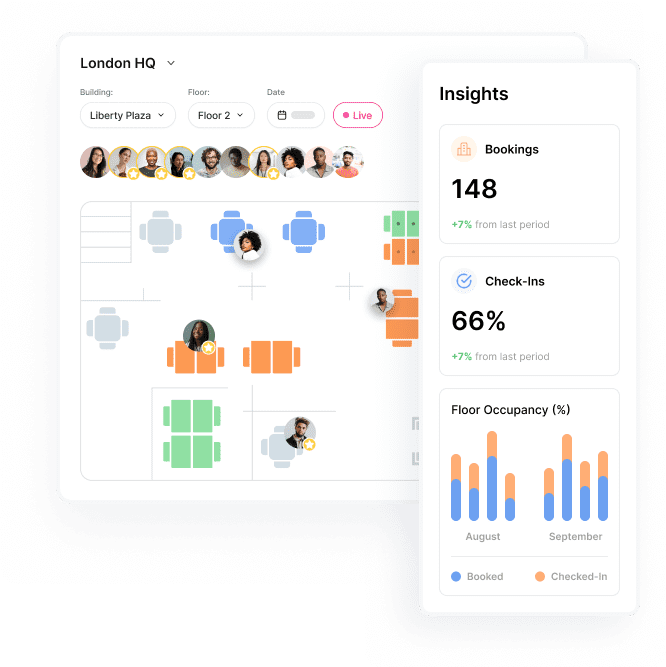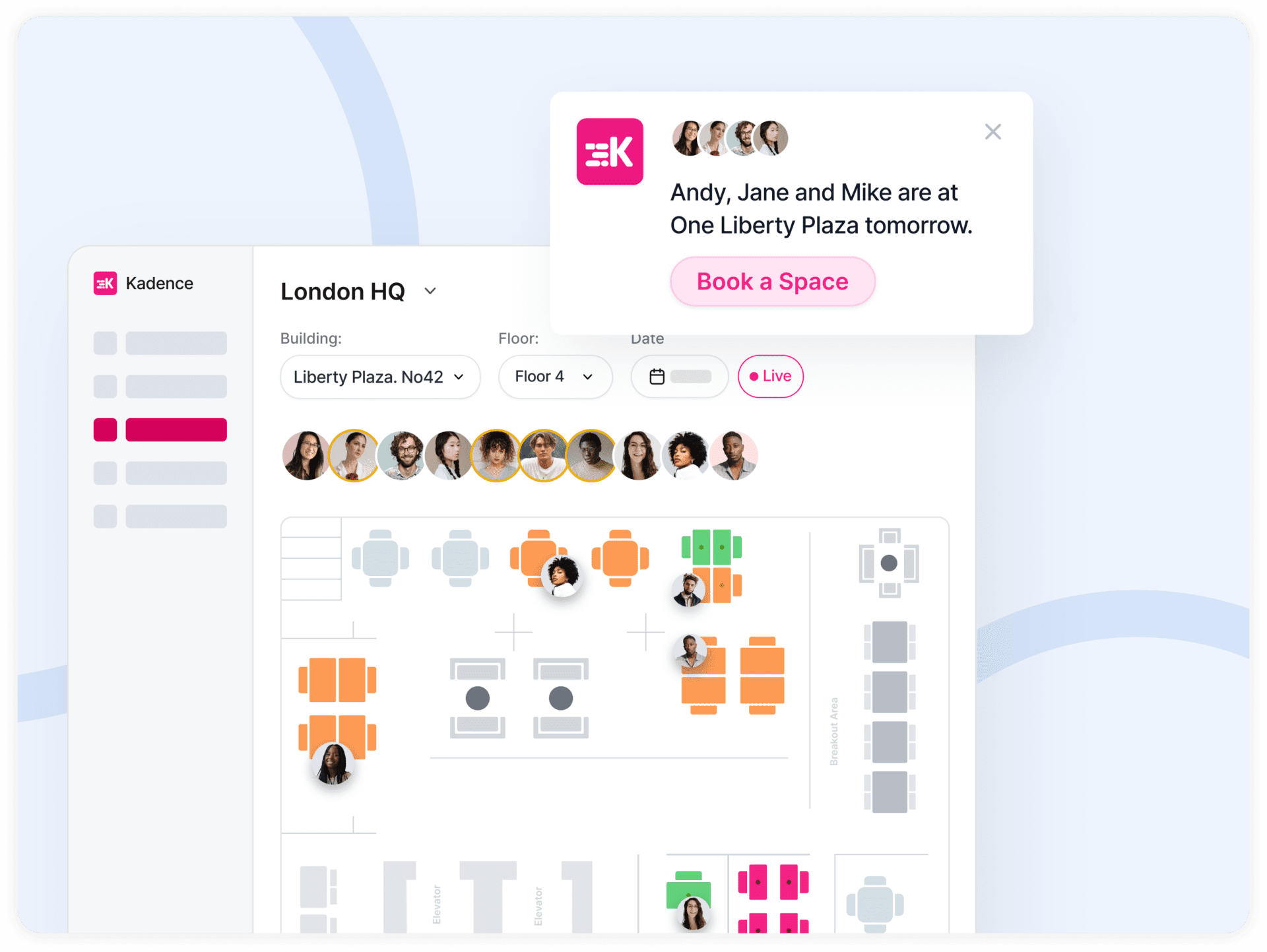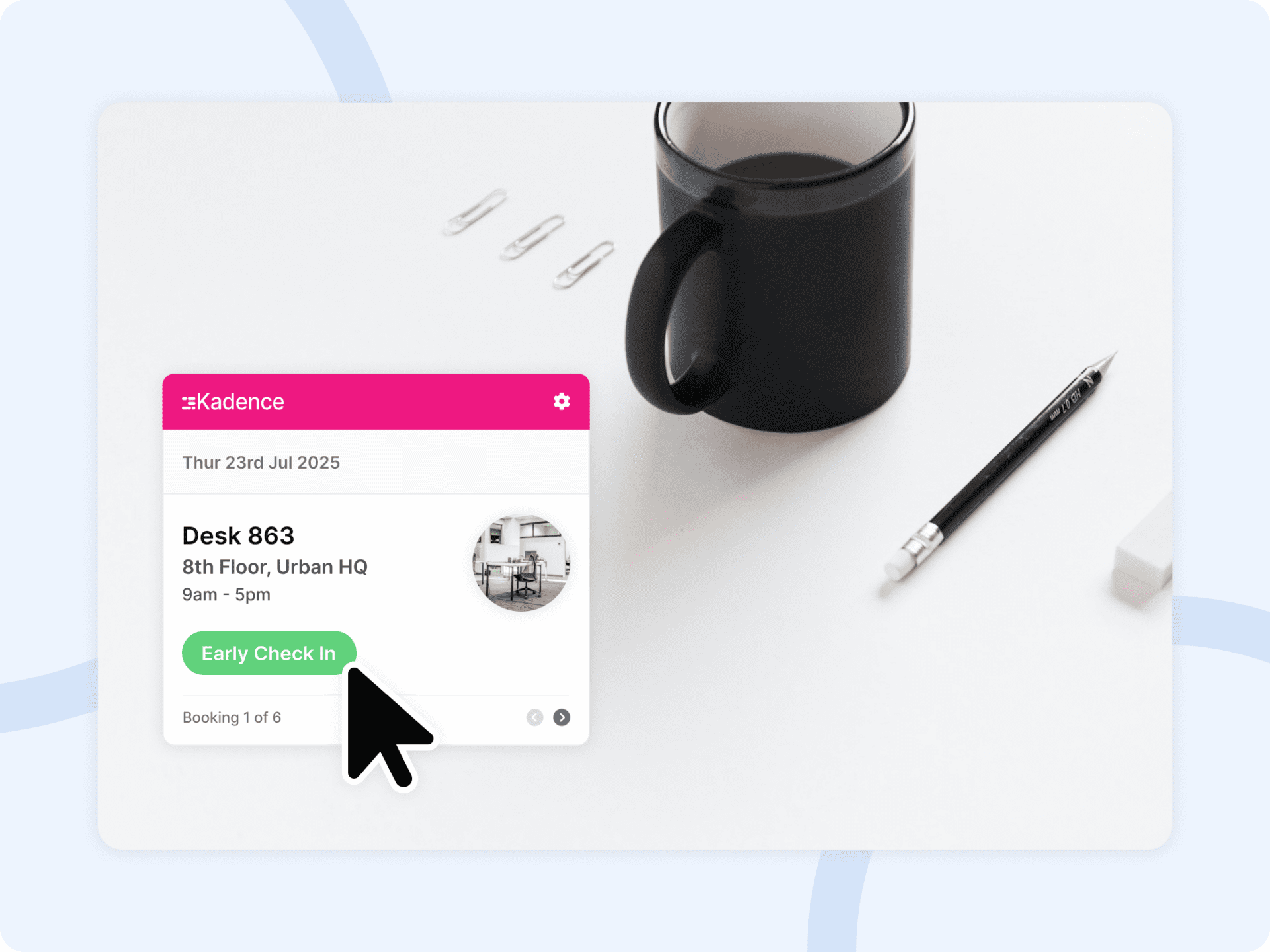What is Office Space Management Software and why is it important?
In the rapidly evolving landscape of the hybrid workplace, understanding and managing physical space effectively through space management software has become a pivotal aspect of organizational success. The shift towards hybrid work models has not only altered our daily routines but also redefined the very concept of workspace utilization.
Efficient space management services now play a critical role in fostering productivity, enhancing employee satisfaction, and optimizing operational costs. At Kadence, we recognize these challenges and have tailored our solutions to meet the unique demands of this new era.
What are the challenges of Office Space Management Software?
Space planning in the hybrid work era is a balancing act between flexibility and efficiency. It involves a strategic allocation of physical space to accommodate fluctuating occupancy, diverse work styles, and varying employee needs.
The challenge lies in managing these dynamic requirements with a space management system, ensuring that resources are utilized optimally.
This is where a comprehensive understanding of space management systems becomes crucial. From addressing the complexities of scheduling and booking to adapting to ever-changing organizational needs, the intricacies of space management are both multifaceted and significant.
What are the benefits of Office Space Management Software?
Downsizing Office Space
Modern office space management software provides data-driven insights that enable businesses to right-size their office spaces. By understanding actual space utilization patterns through space utilization software, companies can make informed decisions about downsizing, potentially leading to significant cost savings without compromising employee needs.
Reducing Costs
The strategic use of space optimization software directly contributes to cost reduction. By optimizing the use of available space, minimizing unused areas, and efficiently managing resources, businesses can substantially lower operational expenses related to real estate and facilities management.
Improving Employee Experience
Workspace management software enhances the employee experience by providing a flexible and responsive work environment. Features like real-time booking systems and usage analytics ensure that employees have access to the spaces they need when they need them, thereby boosting morale and job satisfaction.
Team Coordination and Productivity
Effective workplace planning fosters better team coordination and productivity. It streamlines the process of scheduling and booking resources, reducing conflicts and downtime. This improved coordination ensures that teams can collaborate effectively, regardless of their physical location.
Hitting ESG Targets
Environmental, Social, and Governance (ESG) targets are increasingly important for businesses. Space management software can help in achieving these goals by promoting efficient use of resources, reducing carbon footprint through optimized space utilization, and fostering a more sustainable work environment with the help of environmental sensors.
Space Management statistics
The impact of space management can be best understood through data and statistics that reflect its significance in the modern workplace:
The Changing Value of Office Real Estate
- By 2030, office real estate value could potentially drop by up to $1.3 trillion, a shift driven by evolving work models and space utilization patterns. Companies are on the lookout for workspace solutions that fit their flexible models and allow optimum usage of their office space.
Reduction in Space Requirements
- A study by Mckinsey suggests that remote work and flexible work policies will enable organizations to reduce their need for office space by 30%.
Employee Preferences for Hybrid Work
- Only 6% of U.S. employees in remote-capable jobs prefer to work fully onsite. In contrast, 34% prefer to be fully remote, and 59% favor hybrid arrangements.
- Around 93% of employees voice a preference for hybrid or remote work opportunities. Limiting these options could lead to a higher rate of employee attrition. The cost of replacing an individual employee can range from one-half to two times that employee’s annual salary and US businesses collectively lose about $1 trillion due to voluntary turnover.
Productivity and Employee Benefits
- Of the employers who updated their employee benefits packages after shifting to remote work models, 63% reported increased employee productivity
Cost Savings Through Space Optimization
- Companies leveraging space management tools report up to 30% savings in operational costs due to more efficient space usage and reduced real estate expenditures.
Useful Space Management tools to help downsize office space
In the mission to optimize office space, especially when downsizing, the best space management software can make all the difference. Embracing technology like space control software to manage and analyze how space is used in your organization is key to creating an efficient, adaptable, and cost-effective work environment. From seat management software for desk and room booking systems to visitor management and workplace analytics, each tool plays a crucial role in transforming how we understand and utilize our office spaces. Let’s explore some essential workspace management tools that Kadence offers, designed to streamline operations and enhance the overall workplace experience.
Desk Booking Software
Hot Desk Booking is no longer just about reserving a workspace; it represents the adaptability of an organization to its employees’ varying needs. The ideal system allows for ease of use, and flexibility, and provides real-time insights into workplace utilization. This not only ensures that employees find the right space for their work but also helps in tracking and optimizing desk usage across the organization.
Conference Room Booking Software
Effective room booking is key to maximizing the utilization of meeting spaces, especially in a hybrid work environment where the need for physical meeting spaces can fluctuate dramatically. An efficient occupancy management software can help manage this. Conference Room Booking Software offers visibility into room availability, allows easy scheduling, and provides insights into usage patterns to ensure that meeting spaces cater to a variety of needs and work styles.
A Visitor Management System
To effectively organize your workspace using space allocation software, it’s crucial to first understand the frequency and identity of the visitors utilizing the space. Perhaps your sales department is inviting the most visitors on-site, requiring particular office neighborhoods for meetings. Alternatively, it might be your finance team that often brings visitors on-site to the office. Utilizing a visitor management system will allow you to gather data on the volume and regularity of visitors, so you can facilitate a comfortable check-in process for guests and consider how your employees can appropriately welcome and escort visitors around the office.
Workplace Analytics and Data
A staple when it comes to space management software is Workplace Insights. Being able to visualize and track all of your booking data and space data in one place is the key to optimizing your office space and reducing costs. Understanding the most popular days your team’s book to come in, as well as the most popular spaces your teams use vs. the ones they don’t. Getting to grips with the effectiveness of your hybrid policies by seeing how many canceled or ‘no-show’ bookings there are and seeing all of this, all in one place streamlines all of your process at once.
How does Office Space Management Software work?
To start managing your spaces with facility space management software, first, check out your workspace. Look at how big it is, what each area does, and what resources you have. Using building space management software lets you keep an eye on your spaces all the time. You can see how employees book spaces and use this info to make your workspace better. This way, your workspace can change as needs change and keep being a good place to work. The software can also help you manage floor plans and understand the square footage of your office.
Start with 4 simple steps:
1. Track, manage, and optimize your spaces with a real-time booking tracker
By tracking your bookings as they occur with occupancy software, you not only get to project upcoming reservations but you can see how your spaces are being used in real-time. This allows you to load balance your office and manage them efficiently to meet the needs of your teams and keep every safe. In utilizing a space management solution that provides sophisticated analytics, displayed in an easy-to-understand layout, you’re now able to make strategic choices specifically suited to your team and organization’s needs.
2. Measure the success of your hybrid policy with Attendance Metrics
Grappling with the best hybrid work policy for you and your teams can take time and experimentation to find the right balance that benefits everyone. By visualizing a comprehensive view of all space bookings and cancellations over any given time frame with the best office space management software, you’re able to assess the efficiency of your hybrid work policy by seeing clear attendance metrics at a glance. These data points are crucial in making informed decisions about future office utilization. This is not just about booking spaces; or naming and shaming teams; it’s about strategic space management that aligns with your team and organization’s goals, ensuring no space is underutilized and that unnecessary costs are eliminated.
3. Maximize the use of your resources
Space Management Software provides a streamlined overview of all of your vital resources such as understanding conference room usage over any chosen timeframe. This allows Facility Managers to track room usage patterns, thereby gaining insights into which rooms and resources are more popular than others, or better still, understanding why 3-person meetings are being held in a room with a capacity for 10 people! This data is presented visually through a Room Occupancy Overview Daily Occupancy Heat Map. These combined offer a clear picture of room occupancy rates at different times of the day, providing valuable information for strategic planning and decision-making. It can aid in assessing the efficiency of room usage, identifying underutilized spaces, and implementing strategies to optimize space utilization. This asset management and facility management tool can be a game changer.
4. Download the specific Data you need for reporting
Being able to extract the data you need is a crucial yet key component of Space Management Software. Being able to view, access, and expand each space management widget to observe, enlarge, and export its data with the help of space software. Alongside its easy-to-integrate capabilities with your existing workplace software or reporting platforms, you can utilize Kadence’s sophisticated analytics directly within the Kadence web application itself. A straight-up out-of-the-box solution that allows for data interpretation, analysis, and the implementation of future cost-efficiency enhancements to your spaces all in one place.




